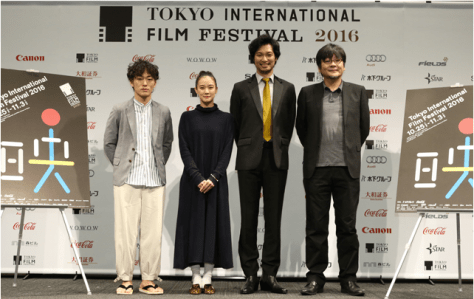By Larry Gleeson.
 Viewed at the AFI Fest 21012 the Egyptian Theatre in Hollywood, Calif.
Viewed at the AFI Fest 21012 the Egyptian Theatre in Hollywood, Calif.
42nd Street, a Vitaphone and Warner Bros. picture, directed by Lloyd Bacon, has stood the test of time as the epitome film about those who dream of becoming a star on Broadway. Long-time and highly successful director Julian Marsh, played by Warner Baxter, returns to produce a final Broadway show despite his poor health. The show’s financing comes from a wealthy older man, Abner Dillon, played by Guy Kibbee, who is in love with the leading lady and star of the show, Dorothy Brock, played by Bebe Daniels. But Dorothy’s not interested in his love, because she’s still in love with her previous partner. On the night before the show’s premiere, Dorothy breaks her ankle, and Peggy Sawyer, a novice chorus girl played by Ruby Keeler, tries to fill the role of the fallen star. Several subplots add an extra dimension giving a deeper emotional attachment to the main characters and a breath of originality to the old Cinderella story line.
As a viewer, look forward to lots of singing and dancing, especially toe-tapping, some excellent use of comedic timing and some highly imaginative mise-en-scene. Yet, also be prepared for a taste of the old backstage Broadway magic and excitement that seems to go hand-in-hand with Broadway shows not to mention, the debut of legendary and ground-breaking choreographer Busby Berkeley, and some rather catchy musical numbers like “Shuffle Off To Buffalo”, “You’re Getting To Be A Habit With Me”, and “42nd Street.” One of the beauties of the film is each musical coincides with an important story event. “Shuffle Off To Buffalo” coincides with honeymooning in nearby Niagara Falls, “You’re Getting To Be A Habit With Me” expresses Dorothy’s feelings for her new lover and the show-stopper “42nd Street,” gives the distinct melding of the elite to the underworld.
Technically, the film is in black and white print and cinematographer Sal Polito provides a very efficient, hard, unglamorous look to the film utilizing for extended dialog a two-person medium full shot extensively, makes good use of tracking shots to guide the viewer’s eyes and uses high overhead shots to showcase the intricacies of choreographer Busby Berkeley introductory work.
I’ve seen the musical “42nd Street” on stage several times and chose to see it on film at the Hollywood Egyptian as I’ve seen Rear Window (Hitchcock, 1954); USA and Lolita (Kubrick, 1962): USA on the big Egyptian screen during previous AFI Fests. All I can say is it’s a real treat and if anyone has the opportunity to see any of the classics at the Egyptian I fully encourage it. Take a minute and check out the trailer. You’ll be happy you did!






 TOKYO —
TOKYO —

